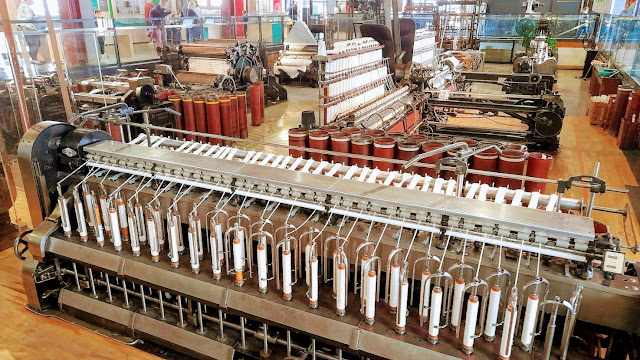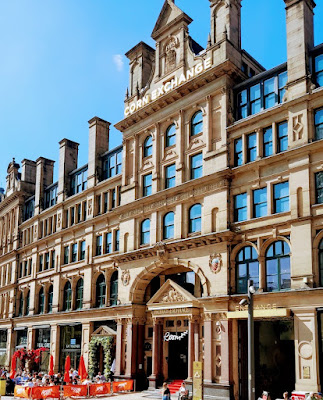Barbara and I were both born and bred in the industrial north of England, in the cotton-mill town of Ashton-under-Lyne, 6 miles from the centre of Manchester, where we spent a few days last week for a nostalgic visit to the world of our youth. We found that Ashton has changed beyond recognition and appears to have lost its soul, but Manchester is now a dynamic thriving metropolis, where magnificent Victorian and modern architecture blend together in harmony.
Manchester was the world's first industrialised city, brought on by a boom in textile manufacture during the Industrial Revolution, and it was the world's largest marketplace for cotton goods during the Victorian era. The dystopian city of the 19th century was a hellish place in which to live and work, and the conditions in the noisy, dangerous and unhealthy cotton mills are brought to life in the city's Science and Industry Museum, which is on the site of the world's first passenger railway station, Manchester Liverpool Road, which opened in 1830.
 |
| Cotton mill machinery in the Science and Industry Museum |
By the mid-19th century Ashton-u-Lyne had emerged as an important mill town at a convergence of newly constructed canals and railways. As Cornwall has its ruined engine houses, so Ashton has its landscape of cotton mills, a reminder of its industrial past.
However, in all my 24 years in Ashton I had never realised its importance as a coal mining town during the industrial revolution, as it lay on the Lancashire coal fields which provided the fuel for the developing industries. Coal mining was not as important to the town as the textile industry, but in 1882 the Ashton Moss Colliery had the deepest mine shaft in the world at 870 metres (2,850 ft), surpassing that of Cornwall's Dolcoath Tin Mine at 660 metres (2160 ft), although Dolcoath eventually reached a depth of 1000 metres (3300 ft) by the end of the century (posting of 3 August 2015).
None of this I knew about in my early life, most of which was spent with my parents and sister in the Ashton Moss Council Estate, only a couple of miles from the Ashton Moss Colliery, then the town's only working coal mine, which eventually closed in 1959. It was known locally as the 'Snipe Pit' and I doubt if many residents now would be aware of its existence, the only reference to Snipe being the name of the retail park which stands on the original mine site, and the nearby pub, the Snipe Inn. Remarkably the deep mine was ventilated by a furnace half way down the pit, supplemented by a boiler fire at the bottom.
Coal was king in 1950s Britain and directly or indirectly fueled our homes. The coal was cheap, low grade and dirty, producing much ash and soot, the airborne particles contaminating buildings and people alike. The Victorian buildings of the industrial north had black facades, highlighting their Gothic gloominess, and it was only in later years, well after the Clean Air act of 1956 that their original sandstone surfaces were restored in all their glory.
 |
| Manchester University before and after cleaning |
 |
| Manchester's Corn Exchange revealed in all its glory |
Many homes, including ours, also had stoves and washing tubs fueled by coal gas (town gas). Ashton, like many industrial towns, had its own gas-works, where coal from the numerous collieries was heated to drive off the gas. The gas was collected in large reservoirs, or gasometers, from where it was piped to local industry and houses, and the residue was coke, a clean but expensive fuel.
The burning of coal in homes and industry produced another hazardous side-effect. Northern England is noted for its rainfall, and the subsequent high humidity provided ideal conditions for minimisation of the breakage of threads in the cotton mills. However humidity and cold winters often produce fog, which combined with the coal-contaminated atmosphere, produced that dreaded combination of smoke and fog known as smog, a noxious mix of particulate matter and gases such as sulphur dioxide and nitrogen dioxide. Often a sickly yellow-green colour, these ‘pea-soupers’ would sometimes totally shut down the activities of a town, but I remember vividly walking to and from school when the visibility was an acceptable metre, with car headlights appearing slowly and eerily out of the gloom. Only towards the end of the 50s did the situation improve, with Clean Air Acts identifying ‘smokeless’ zones, where only smokeless fuels such as anthracite and coke could be burned.
The first four years of my life were spent with my parents and maternal grandparents, latterly in my grandparents back-street general store. Although mum and dad lived at the shop for only a few years, as primary school was only a couple of minutes walk away lunch (dinner!)was spent at the shop for the first few years of my schooling.
 |
| With friends at my grandparents shop, November 1949 |
Cobbled streets, back-yards, outside lavatories; these are some of my most vivid memories of life in the early 50s. The outside lavatory did not have a flushing system, and was operated by a ‘tippler’ system. Waste would remain in an open sewer until the tippler filled with the waste kitchen sink water; it would then tip, sending a couple of gallons of water through the system flushing the waste away. It was counterbalanced at the back so that it returned upright when empty. Using 'grey'water in this way sounds very environmentally friendly, but in reality is wasn't!
A regular visitor to our cobbled back streets was the rag-and-bone man, with his horse and cart rattling over the cobbles. He would collect old rags, for converting into fabric and paper, bones for making glue, scrap iron, old jam jars and other items in return for items of limited value. We children would often trade such items for goldfish and balloons, but the women of the district would eagerly await his supply of much-needed ‘donkey-stones’.
Donkey-stones were soft scouring stones, originally used in the textile mills to provide a non-slip surface on greasy staircases. The stone, which took its name from the hard work performed, was made from pulverised sandstone, cement, bleach powder and water. Working class women had hard lives of drudgery and routine, and the donkey-stoning ritual, which was unique to northern England, was an essential part of their weekly routine. One day of each week would be devoted to going down on hands and knees and donkey-stoning doorsteps, windowsills, the flagged kitchen floor, and most importantly, the paving stones, or ‘flags’, outside their terraced homes. “Sanding the flag” was an ideal occasion for neighbourly gossip, but women were proud of their donkey-stoning, and would feel that anyone whose step was not meticulously sanded would have let the street down.
 |
| 'Sanding the flags' in the 1950s |
With such an upbringing it is not surprising that Barbara and I have always been avid viewers of the long-running 'soap opera' Coronation Street which has run continuously since 1960. The programme centres around an eponymous cobbled, terraced street in Weatherfield, a fictional town based on inner-city Salford, the home of Granada Studios, which we visited last week to explore the set.
 |
| A potential sundowner venue? |
Barbara was also brought up in a working class family, the eldest of six children. Her father was a bus-conductor, and collected tickets on one of the local bus routes. One of his regular passengers was a shabbily dressed old man, who he befriended, and occasionally turned a blind eye to collecting his fare. The old man confided that he was a bit of an artist, and offered Barbara's dad one of his paintings, which he politely declined, as he did not wish to take anything in return for his kindness. Later it was discovered that the old man was one of Manchester’s most famous sons, the artist L.S. Lowry, who died in 1976. His paintings of scenes of life in the industrial districts of northern England during the early 20th century now sell for fortunes, his ‘matchstick men’ figures have often been criticised as being naïve, but a large collection of his work is on permanent public display in a purpose built Manchester art gallery appropriately named The Lowry.
 |
| With my sister Pat at the Lowry Exhibition |
Barbara and I spent most of our youth and childhood separated by about 2 miles, living unaware of each other until 1962 when we met at the local youth club.
 |
| 1963: The first of many photos of Barbara and me; Barbara with my sister Pat; and with friend Tony Marland en route to one of our many parties |
It was great to meet up last week with our oldest friends from that time, Tony and Nora Marland, and Eric and Pat Nield. We had lunch at one of our old watering holes, the Broadoak Hotel, once the site of another of Ashton's coal mines, the Broad Oak, which closed in 1901.
 |
| Tony, Pat, Barbara, Eric, Nora and me at the Broadoak Hotel, Ashton |
Eric and I were at Grammar School together and were members of the junior football team.
 |
| Ashton Grammar Juniors 1958: Eric is back row 2nd left and I am centre, front row |
Shortly after this picture was taken a weaselly litle history teacher caught me and others smoking in the showers after a match in Oldham, and, as captain, I was made an example of, and banned from playing football again for the school- I didn't play competitively again until 1967 at Leeds University! But football remained an important part of my life and I was a fanatical supporter of Manchester City, my dad taking me regularly to home fixtures at Maine Road, but indelibly etched in the memories of Mancunians of a certain age is the event of February 6th, 1958.
I remember dad coming home for "tea" to inform us breathlessly that a plane carrying the Manchester United team had crashed after a European Cup tie, and there were many fatalities. United was, of course, the ‘other’ Manchester team and there was intense rivalry between local supporters. Feelings softened, however, when the whole of Manchester came together after the Munich air disaster, which claimed the lives of eight of the Manchester United team, and during the early sixties Barbara and our friends and I would often drop in at Old Trafford of an evening to watch the legendary threesome, George Best, Bobby Charlton (one of the survivors of the crash) and Denis Law in action. It is well over 50 years since I was last at the ground, so it was good to make a brief visit last week.
Another vivid memory is of a night at the youth club in late 1962, where the place was buzzing and the chatter was all about a new group from Liverpool which had been on local TV that night. They were called The Beatles and they had an immediate impact on us all and played a big part in our lives in the 60s, and we have been great fans ever since. Until last week I had only ever visited Liverpool once, for interview at the University in 1963 (I opted for Leeds), so we took the train last week from Manchester to Liverpool Lime Street, for a 'Magical Mystery Tour' of the city.
It was a great week of nostalgia, and I would very much like to hear from you if you were also part of the industrial scene in the middle of last century.







.jpg)





























-EDIT.jpg)




